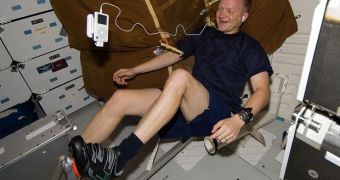Not only high-speed space debris pose serious threats to the astronauts on the International Space Station. The bodies of the crew members themselves may betray them, experts say, if the exercise routine is not changed soon. In the past, studies on astronauts showed that those returning from long stays, of 4 to 6 months, experienced a loss in bone and muscle mass, on account of the effects of weightlessness. The brain feels that the large amount of muscles is no longer required, seeing how the astronauts float from one place to the other, and seeks to cut its consumption.
And while this works like a charm in the micro-gravity environment of Earth's lower orbit, it does not back on the ground, where space fliers need to be able to walk on their own feet. According to the Ball State University's Human Performance Laboratory (HPL), which has been recently commissioned by NASA to conduct a new study on the matter, under the existing exercise routine, astronauts are currently very likely to lose large amounts of muscle mass. Therefore, the entire fitness program needs to be overhauled, the conclusion of the report points out.
Exercising aboard the ISS is paramount to both the astronauts' health and performance, as well as to the success of the overall mission. If the crew were to become incapacitated, then there would be very small chances of a rescue team getting there in time to save them. That's why the cardiovascular system, the bones, and the skeletal muscles are the main targets of “sports” on the orbital facility. The bicycle is the most frequently used machine in the ISS “gym,” as the current exercising instructions hold.
The Biological Sciences Department at the Marquette University, which has also collaborated with NASA for the new research, has found that astronauts who return from the space station exhibit a 15-percent muscle mass loss, as well as a 20 to 30 percent decrease in muscle performance.
“By clinical standards, this is a massive loss. This approaches what we see in aging populations in comparisons of a 20-year-old versus an 80-year-old. This poses risks to the crew members and could have a dramatic impact on locomotion and overall health, which would impact a variety of crew members' activities including future goals of planetary exploration,” the Director of HPL, Scott Trappe, explains.
“From our bed rest studies, we found that when high-intensity resistance and aerobic exercise are balanced correctly, this is an effective prescription that is quite therapeutic in protecting skeletal muscles in a simulated micro-gravity environment. The next step is to apply what we have learned from the ISS experience and implement the next generation of exercise prescription programs into the space environment. Intensity wins, hands down,” he concludes.

 14 DAY TRIAL //
14 DAY TRIAL //